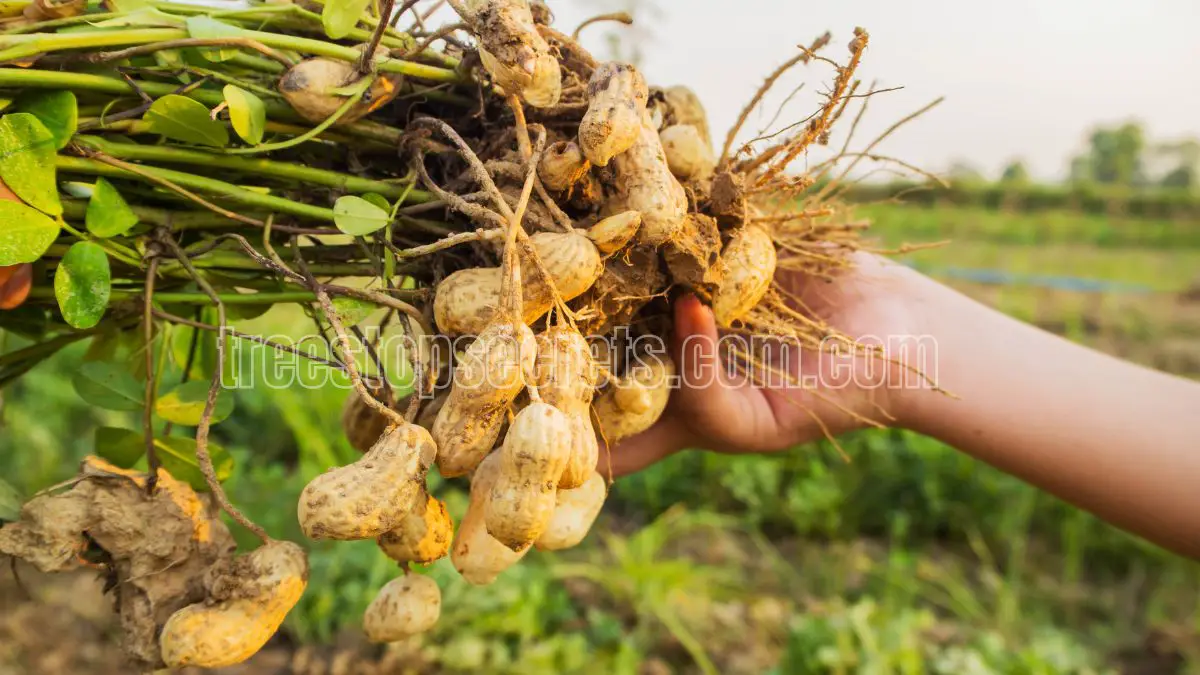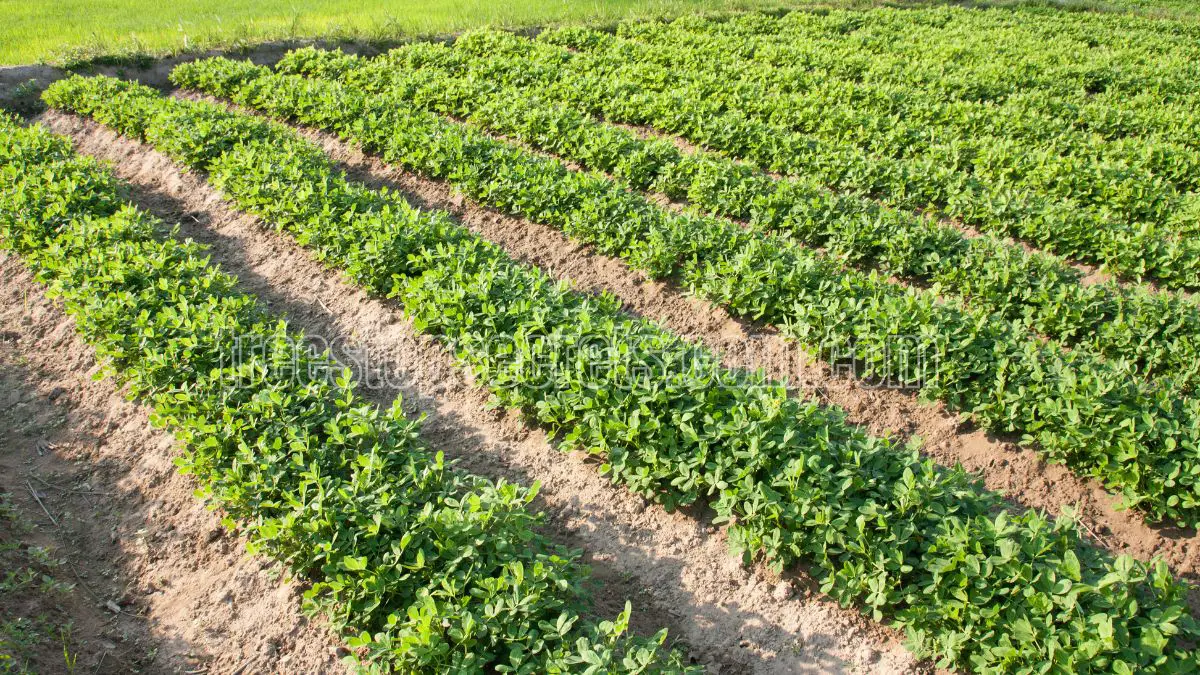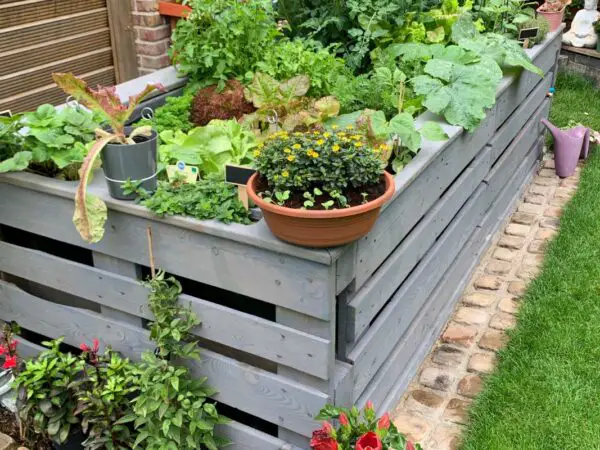The major steps to planting and growing peanuts are essential to producing a successful harvest. Here are some pointers on growing peanuts.
First, it’s important to choose the correct variety of peanut, as different varieties do well in different climates and soil types. Clearing the ground, making sure the soil is well-drained and nutrient-rich lays a great foundation.
Planting should be done after the last frost, preferably on a warm sunny day to ensure a vigorous seedling. Consistent watering, particularly in dry periods, is critical to keep them from going dry.
Controlling pests and diseases is extremely important to keep the crop safe. Mastering these practices will not only improve the bottom line yield, it’ll help create a more sustainable way to grow peanuts.
In this guide, we’ll break down each step to help you successfully grow and harvest your own peanuts.
Key Takeaways
- Select well-drained sandy soils for planting peanuts to allow for adequate drainage and deep root penetration. Test your soil and make sure the pH is between 6.0 and 6.5, adding lime if needed.
- Select a peanut variety that adapts well to your climate. Plant disease-resistant varieties to reduce disease crop loss and increase your yield potential.
- Ensure seeds are planted no less than 5–7 cm deep and 30–50 cm apart to ensure a healthy plant. Keep an eye on local frost dates and wait to plant until the end of late spring, when the soil temps are above 65°F.
- Understand the important peanut growth stages – germination, flowering and pegging. This understanding will allow you to properly scout their growth and address any problems that come up.
- Create a consistent irrigation plan, especially during flowering and pod filling stages, and use mulch to help retain soil moisture.
- Know the peanut plants’ major pests and diseases. From there, employ organic pest control measures and prioritize soil health to build the strength of your crops.
Soil Preparation for Peanuts
Soil preparation is one of the most important tasks for farmers growing peanuts, as it builds the foundation for healthy peanut plants and maximum yield. Knowing which soils are suitable, proper pH levels, and the best management practices is key to a successful peanut harvest.
1. Identify Optimal Soil Types
Selecting the right soils is absolutely critical, because they encourage excellent drainage that facilitates deep, well-established roots. Light, sandy soils hold moisture while providing good aeration, which is favorable to peanut development.
If you don’t mind, please avoid heavy clay soils! They are prone to heavy drainage, which can drown the roots and cause stunted growth.
2. Assess pH Levels and Nutrient Needs
Testing soil is a critical step to take prior to planting in order to know pH and nutrient levels. Peanuts do best with a pH of 6.0 to 6.5.
If soil amendments are required, insert lime into the soil. Make sure to incorporate it two to three months prior to planting. In low-nutrient situations, a late fall application of 7 pounds of 0-20-20 fertilizer per 1,000 square feet does the trick.
This method works best when you don’t have a soil test on hand, of course.
3. Implement Innovative Soil Management Practices
Cover crops improve soil structure and protect against erosion, and mulch helps conserve moisture and control weeds.
If fertilizing with compost, apply no more than 1 inch of well-composted organic matter per 100 square feet. This practice will do wonders in revving up your soil’s fertility.
4. Importance of Crop Rotation for Soil Health
Planting peanuts in rotation with other legumes or grains provides benefits to the soil by improving nitrogen levels. This practice not only builds soil structure and habitat but breaks pest and disease cycles, providing lasting health to our soils.
After harvest, shred remaining plant material and either incorporate it back into the soil or compost it to regenerate nutrient-rich soil.
Selecting the Right Peanut Seeds

Selecting the right peanut seeds is one of the most important steps to ensuring a successful harvest. Choosing seeds that are bred and tested for your local conditions from a reputable seed company improves germination, disease resistance, and vigorous healthy plants.
Learn about peanut varieties such as Virginia, Runner, and Spanish peanuts. This can help you select the best fit for your garden’s unique growing conditions.
1. Explore Different Peanut Varieties
Virginia and Runner peanuts are well-known for their adaptability to varied climates. Spanish peanuts usually grow best in the cooler areas.
Choosing disease-resistant varieties, whenever possible, can help reduce crop loss by a large margin, especially in times of severe weather. For example, Tennessee Reds and Virginia Jumbo have shown to be hardy in a variety of conditions.
2. Evaluate Yield Potential and Pest Resistance
Evaluating the yield potential of selected varieties is crucial for making your potential harvest as abundant as possible. Not all varieties will yield the most peanuts, so knowing what to look for will help you choose the right variety for your needs.
By selecting seeds with built-in pest resistance, you reduce the need for chemical treatments. This evidence-based decision fosters a more sustainable and healthier growing environment.
3. Consider Environmental Stress Factors
The local climate conditions, like the temperature range and rainfall patterns, are an important factor in seed selection. For those in northern climates, selecting peanut varieties with a shorter maturity period is essential.
Choose for short-maturing varieties, ideally 110 days or less. A soil temperature of 65°F at planting is ideal and important for good seed germination.
Effective Planting Techniques
The key to a successful crop of peanuts starts at planting, with methods that stress early, vigorous growth and heavy yield. It’s all in the detail. Preparing the planting beds is key. Proper tilling and leveling of the soil helps guarantee an even seed bed, which is key to getting uniform growth.
When direct sowing, sowing seeds 30–50 cm apart will give each seed 30–50 cm of space to grow without competing for other plants’ resources.
1. Determine Ideal Planting Depth and Spacing
Plant peanuts at a depth of 5–7 cm to ensure adequate germination and root development. Having the correct and consistent spacing is very important for plant health.
To maximize air circulation and sunlight exposure, maintain a minimum of 20 inches between rows. For planting outdoors, plant 2 inches deep for each seed. Plant the seeds 18 inches apart, and if possible plant in mounds of four seeds per mound.
2. Choose the Right Timing for Planting
Timing Peanut planting is timing sensitive. Choose late spring, once soil temperatures are consistently above 18°C (65°F).
Keeping a close eye on local frost dates can help avoid early planting in areas with cooler climates, giving plants a strong start to the growing season. In cooler areas, peanuts can be started 5 to 8 weeks before transplanting outdoors for an earlier harvest.
3. Utilize Precision Agriculture Tools for Monitoring
Implementing soil moisture sensors throughout the growing season allows for precise tracking of watering needs, ensuring plants receive 1 to 2 inches of water weekly to maintain uniform soil moisture.
Leveraging GPS technology can further help map out optimal planting layouts, leading to more efficient field management practices.
Understanding Peanut Growth Stages
Peanut growth unfolds through distinct stages: germination, flowering, and pegging, which are crucial for successful peanut farming. Knowing these growth stages allows gardeners to monitor their peanut plant flowers closely, enabling them to recognize any issues early in the peanut harvesting process.
1. Germination Process Explained
Peanuts typically take 7 to 10 days to germinate. They are very sensitive to soil temperature, preferring a soil temperature of 70°F (21°C) for germination. They need sufficient moisture for successful seedling establishment.
Even moisture is important at this point. The seeds need to take up water to hydrate, swell, and break dormancy. Soil that is too dry or wet may prevent proper emergence of the seedling. Frequent monitoring of soil moisture levels will aid in finding this balance, ensuring healthy seedling establishment.
2. Overview of the Flowering Phase
After germination, the next stage for the peanut plant is flowering, characterized by yellow flowers. These flowers are key to pod formation, with pollination happening soon after the flower opens. Good pollination leads to pod-filling.
Because this entire process takes place below ground, it’s very important to maintain plant health during this period. Observing flower health and ensuring a thriving environment can significantly impact yield.
3. Unique Characteristics of Pegging
In the pegging stage, the fishers elongate, rooting into the soil, and this is where the peanut pods really start to take shape. This unique characteristic is important not just for the plant itself, but for the development of the peanuts.
Keep a close eye on the pegging process to make sure the pods are forming properly. This practice ensures that the plants are getting the nutrients and moisture they need. Focusing on these characteristics during the pegging stage will help to ensure a successful harvest.
Water Requirements for Peanuts
Peanuts have high water requirements. This is critically important during reproductive periods such as flowering and pod set. These stages need enough moisture to promote vigorous vegetative growth and to maximize yield potential.
Specifically during flowering, plants need a steady supply of water to encourage blossom development. Then, in production stages of pod development, they require sufficient moisture to allow the pods to fill out correctly. Thus, having a proper grasp of these requirements can make all the difference when it comes to successful peanut production.
1. Assess Irrigation Practices for Different Climates
Plan irrigation practices for specific climate zones and rainfall conditions. In extremely rainy regions, growers might need to irrigate less, and in drier climates, peanuts will need to be watered more often.
Drip irrigation systems are incredibly efficient, using up watering to the root zones. This method prevents unnecessary water waste while delivering moisture directly where plants need it most.
2. Develop Effective Water Management Strategies
Incorporating rainwater harvesting methods, such as cisterns and permeable pavement, can help meet irrigation demands while improving sustainability. Rainwater harvesting infrastructure, such as gutter systems that connect rooftops to storage tanks or cisterns, can supply water in dry periods.
Applying mulch around peanut plants can reduce evaporation by as much as 90%. This, in turn, helps conserve soil moisture and creates a more stable environment for optimal growth.
This practice helps with water retention and helps to keep weeds down, which is an additional benefit for the peanut crop.
Nutrient Management and Fertilization
Proper nutrient management and fertilization are crucial for maximizing peanut yield potential. By understanding the specific nutrient requirements for growing peanuts and applying fertilizers based on soil test results, farmers can significantly enhance crop yield and quality.
1. Key Nutrient Requirements During Growth Stages
Peanut plants may require different nutrients depending on their current growth stage.
-
Nitrogen requirements during the first growth stages. Promoting leaf and stem growth, allowing the plant to build a firm vegetative foundation. For instance, when establishing new plants, the use of nitrogen-rich fertilizers can be beneficial, promoting the healthy growth of young plants.
When flowers enter bloom stage, the role of potassium becomes absolutely crucial. Proper potassium levels promote pod development and overall quality of the peanuts.
What Farmers Are Seeing: Farmers typically find that additional potassium at this stage improves overall yield and pod size.
2. Establish Fertilization Schedules for Optimal Growth
Developing a fertilization calendar is essential. Develop a calendar for nutrient applications to help them happen on time throughout the growing season. This schedule allows for the timely, systematic response to the changing nutritional needs of the peanuts throughout their growth cycle.
Continually monitor plant growth and health so you can make changes to your fertilization plan. For example, if you begin to see leaf discoloration or stunted growth, it could be a sign that your plants are lacking a certain nutrient.
Simple, quick changes in the fertilization approach can make a big difference in establishing vigorous growth. Soil tests are instrumental in deciding what type and how much fertilizers to use. This way, plants get just the right amount of nutrients to help them thrive.
Common Issues in Peanut Cultivation
Although peanut cultivation, particularly of good peanuts, is extremely rewarding, it presents many challenges. These problems are largely a result of insect pest and disease pressures, often causing major losses in yield and market quality for peanut crops. Knowing the common issues is key to a healthy peanut harvest.
1. Identify Pests and Diseases Affecting Peanuts
Common pests like aphids and caterpillars can do serious damage to peanut plants. Habitual scouting is extremely important. Growers should scout plants at least once a week to detect infestations as quickly as possible.
In addition, accurate detailed records of pest occurrences will assist in the development of effective management strategies, enabling timely interventions to minimize their impact. Fungal diseases such as pod rot are an important risk factor, resulting in reduced yield.
Identifying these issues early on can greatly impact the overall health of the peanut crop.
2. Explore Organic Pest Control Methods
You can even use beneficial insects, like ladybugs, to help naturally control pest populations. By following this approach, the ecological balance can be saved, and chemical input can be reduced in a sustainable manner.
If problems continue despite these efforts, certified organic pesticides use can be a last resort solution. Using these tactics is better for the environment and improves soil health, making sustainable farming practices the right choice.
3. Troubleshoot Common Growth Problems
Having the right soil conditions is essential for peanuts to thrive. Problems such as low germination rates or slow growth may be more related to soil conditions than you think.
Maintaining optimal pH and drainage conditions can promote healthy, robust plants that are less susceptible to disease. A deeper understanding of environmental stressors like drought or too much moisture is key to tackling these growth issues head on.
Harvesting and Curing Peanuts

Harvesting and curing peanuts are crucial, labor-intensive, and detail-oriented steps in the peanut harvesting process to produce high-quality flavor peanuts. Understanding handling techniques and proper timing can significantly impact the final product.
1. Recognize the Right Time to Harvest
To start with, you need to be prepared to harvest when the peanut plants indicate they are fully matured. Look for brown pods and yellowing leaves to know when the peanuts are ready for harvest.
A good first test is to carefully dig around the base of the plant to evaluate growth and development of pods. This lets you find out if most of the pods are plump and firm when you pinch them.
Most importantly, this is the time peanuts should be harvested to have the optimal flavor and texture.
2. Learn Curing Techniques for Quality Peanuts
After harvesting, curing is the most important step of the process in developing the peanuts’ flavor. To properly cure peanuts, spread them out in a hot, dry, windy location.
This curing process is important in creating the unique flavor that so many love. Proper storage is also essential.
Once cured, it’s important to keep the peanuts in a cool, dry location. If stored properly, peanuts will not spoil and can be enjoyed fresh for years to come.
Well-cured peanuts are irresistible snacks. They’re delicious and versatile ingredients to use in all kinds of recipes, so the work put into harvesting and curing them is more than worth it!
Conclusion
Whatever the reason, growing peanuts provides an enjoyable challenge for novice and expert gardeners alike. It all begins with proper soil preparation and selecting quality seed. Make sure to plant at the proper time and pay close attention to plant growth stages. Monitor watering requirements and apply fertility for maximum yield potential. By keeping an eye out for these common threats, you can better identify and address problems before they worsen. Flavor and quality harvesting is a tricky business, as timing is everything.
When given the proper attention, you can savor home-grown peanuts in your savory dishes or sweet treats. Enjoy the ride, find out what works best for you, and bring your fellow travelers along with you. Whether you garden for the joy of it or to bring good food home, peanuts will deepen your experience and reward you with deliciousness. Take the first steps toward growing your own peanuts today!
Frequently Asked Questions
What type of soil is best for planting peanuts?
Peanuts, a fascinating legume, grow best in sandy, well-drained soils with a pH of 6.0 to 6.5, making them ideal for a home garden. Good drainage is essential to avoid root rot.
When is the best time to plant peanuts?
When to plant peanuts Plant peanuts after the last frost date in your area, which will be late spring. Soil temperatures of 65°F and above are needed for good germination.
How deep should I plant peanut seeds?
How deep should I plant peanut seeds in my garden? This depth protects the seeds from soil pests and ensures enough moisture for good peanuts.
How often should I water peanut plants?
Peanut plants require approximately 1 inch of water per week, which is crucial for growing quality peanuts in your garden.
What nutrients do peanuts need?
What nutrients do peanuts need for optimal growth? Using a balanced fertilizer formula is essential for strong, vigorous growth and healthy peanut crops.
How do I know when to harvest peanuts?
Peanuts are ready to harvest when the foliage turns yellow and begins to fall off, indicating the peanut harvest is near. Be sure to dig them up carefully to avoid damaging the juicy pods inside.
What are common pests for peanuts?
What are some pests that peanuts face in a peanut farm? Common pests for peanuts, such as aphids, whiteflies, and root knot nematodes, can affect the quality seeds. Keep an eye on your plants and use organic pesticides accordingly.
Image Source: Paid image from CANVA



